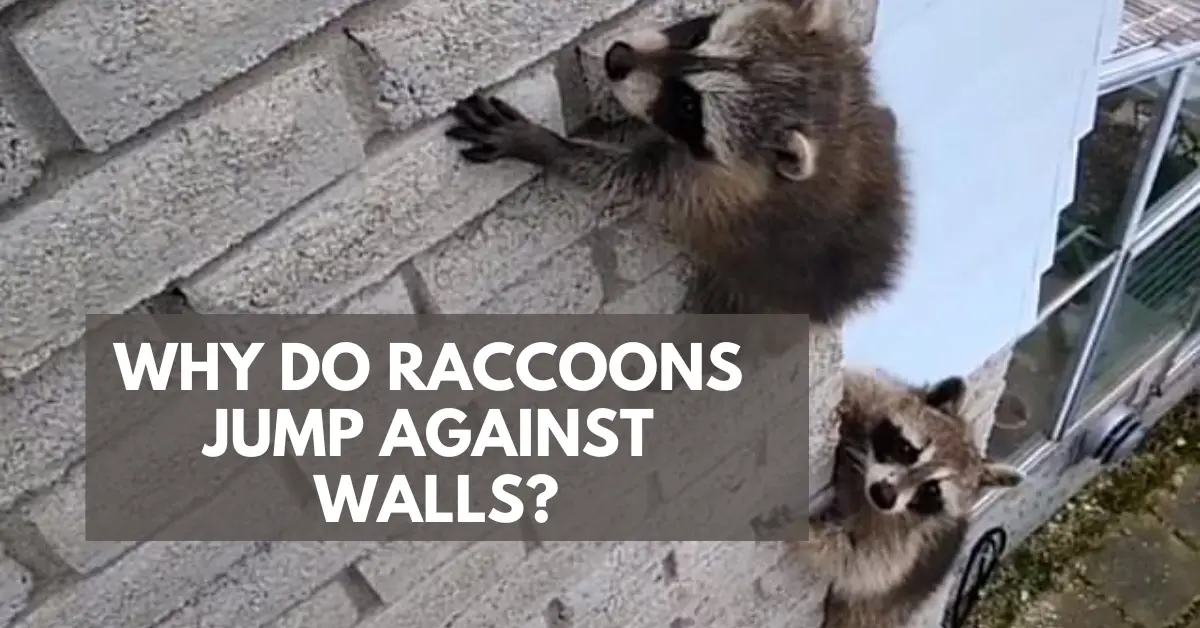Raccoon Jumping Against Your Wall? See Reasons And How To Stop Them

Have you ever asked yourself this question: why do raccoons jump against walls? We will be determining why they do that because there must be a reason for something to happen. This may be one of the reasons why raccoons jump against the wall; for instance, when a single mother raccoon seeks a mate, she often dismisses her babies to scout the area for potential partners.
Contents
- 1 Why Do Raccoons Jump Against Walls?
- 2 Can Raccoons Climb Walls?
- 3 Can Raccoons Jump Or Climb?
- 4 How High Can Raccoons Jump Up Vertically?
- 5 How Far Can Raccoons Jump Horizontally?
- 6 Can A Raccoon Jump Down From High Wall?
- 7 Can Raccoon Get Through Walls?
- 8 How To Keep Raccoons From Jumping Against The Wall
Why Do Raccoons Jump Against Walls?
Mother raccoons utilize jumping as a means to signal their young. While exploring, young raccoons frequently encounter tall walls or other barriers. Jumping against these obstacles produces a loud noise that their mothers and other potential mates can detect.
Also, raccoons have several advantages in jumping against walls. It helps them maintain their agility and overall activity levels, serving as a form of exercise. Moreover, this behavior assists them in marking their territory, deterring other raccoons from encroaching. Additionally, it can aid in locating food sources and suitable shelter.
Can Raccoons Climb Walls?
As a homeowner, if you want to know if raccoons climb walls, then the answer is Yes: raccoons can climb the walls to access your house. They are known to be good at climbing, allowing them access to your house, roof, and attic. They can scale most home materials like wooden and chain link fences because they are easily scalable.
Also, raccoons can jump against the walls of your house, whether it is vinyl siding, wood, or brick walls. Raccoons are much more likely to climb the tree to access your roof. Raccoons need to improve at climbing unweathered sheet metal and glass. In other words, raccoons can be prevented from climbing your roof if you wrap the corner of your house with sheet metal.
Can Raccoons Jump Or Climb?
As always, raccoons are persistent and resourceful animals. They can gain access to your house, yard, and garden and destroy the crops you have invested so much in. Raccoons are excellent jumpers, runners, climbers, and swimmers. This is why catching them is always challenging for homeowners; that is why only professionals can handle them.
It is not hard to spot a raccoon perched in your attic, on your fence, up a tree, or even on your rooftop. Despite not being known for their jumping abilities, these creatures can reach impressive heights of up to 4 feet.
Considering their stout, heavy bodies, you may not expect them to be capable of such feats. But note that raccoons possess surprising agility, which helps them to leap heights similar to feline animals. Although they may not have exceptionally powerful leg muscles, they can navigate vertical and horizontal jumps. Consequently, scaling to the top of houses and fences is well within their capabilities.
How High Can Raccoons Jump Up Vertically?
Raccoons are not known for making amazing vertical jumps. Their legs are relatively short and sturdy, and this limits their ability to leap very high. On the norm, they can only jump up to about 4 feet.
Raccoons are not built for jumping, but they are resourceful animals that can adapt to their environment and thrive. If you find one on your rooftop, chances are that raccoons don’t jump against the walls like that. It is more likely that it climbed up using something close by. Generally, raccoons are better at jumping down from objects rather than leaping over them.
Although their vertical jump is limited, raccoons can still scale up to 40 feet and land safely due to their unique anatomy. Their shorter front legs and longer hind legs give them an arched shape when they run.
Raccoons are also known for their sluggishness, especially when summer approaches when they tend to gain weight. This extra weight can further limit their jumping ability. You may wonder why squirrels, which also have short limbs, can jump higher than raccoons. Unlike raccoons, squirrels have many predators, so they have evolved to be faster and more agile to escape danger.
In addition, raccoons are not known for chasing after prey. Instead, they rely on their cunning skills to hunt while their prey is in their nests, knowing they cannot efficiently run.
How Far Can Raccoons Jump Horizontally?
We have established that Raccoons can jump, and this is because of their anatomical structure. Their long hind legs allow them to extend their bodies and leap forward rapidly. With this skill, they can jump up to 5 feet when starting from the ground and up to 10 feet from a higher point.
This agility allows them to move between trees or buildings effortlessly. However, it’s important to note that they have limits due to their paw structure. A raccoon that tries to jump beyond these distances could lead to injury.
Can A Raccoon Jump Down From High Wall?
Yes, raccoons can jump from significant heights and even land on people or animals, which can cause potential injuries with their impact or bite. What is remarkable about raccoons is that they often emerge unscathed from these leaps.
While not particularly thick, their fur provides some cushion effect against injury. However, this doesn’t mean raccoons are immune to harm when they jump against the walls or fall from heights.
Raccoons can sustain injuries if they land on hard surfaces or miscalculate their jump. Interestingly, raccoons are generally heavier than cats, weighing between 13-20 pounds. This establishes that more serious animals are more prone to injury when falling from heights than lighter ones, making raccoons more prone to severe falls.
In all, raccoons are brilliant creatures and adept at landing safely. Like cats, they have a knack for positioning themselves mid-air to ensure they land well. Whenever they fall, they perform acrobatic maneuvers like front or back flips, rotating their bodies to land on their feet.
For emphasis, raccoons perform mid-air twists, extending their front legs to maximize their reach before touching the ground. This landing technique, landing on their paws first, followed by their legs, minimizes the risk of injury and ensures a safe touchdown. This skillful maneuver also helps them avoid falling onto their backs.
Can Raccoon Get Through Walls?
Yes, they can go through walls. Raccoons are very good and known for their clever break-ins into homes. They often target attics, garages, trash cans, compost bins, and occasionally basements and crawl spaces.
In some cases, they may even invade your residence within the walls of your home, although this is less common and only sometimes seen in older or cottage-style houses. In areas like Keswick, Ontario, where many homes have a cottage aesthetic, walls may have wider voids, which makes them more accessible to raccoons.
Crawl spaces are particularly vulnerable, which provides direct access beneath the home where vents are distributed for heating and cooling. Raccoons infiltrating crawl spaces can easily navigate the house, exploiting openings or gaps. However, raccoons can access walls from the crawl space or the attic. However, it is not advisable to cut into the wall to investigate!
How To Keep Raccoons From Jumping Against The Wall
If you have raccoons hanging out around your place, you’ve probably been woken up by the sound of them bumping into your walls. It’s a loud and heavy-thumping noise, especially when it happens at night. But have you ever wondered why raccoons jump against walls?
Raccoons may exhibit wall-jumping behavior for various reasons. One possibility is that they’re simply attempting to reach something on the other side of the wall, such as a bird’s nest or a tempting morsel just out of reach. Another reason could be their attempt to garner attention.
Raccoons are brilliant creatures and understand that humans make noise when active. If they seek attention for any reason, banging on walls could be their way of doing so.
Additionally, wall-jumping serves as a form of play for raccoons. Like all animals, they require exercise and opportunities to release pent-up energy; wall-jumping might fulfill that need.
No matter the reason why raccoons jump against the walls, it’s frustrating (and sometimes even unnerving) for homeowners. If you’re eager to prevent raccoons from jumping on your walls, there are a couple of steps you can take:
Firstly, ensure nothing entices them on the wall’s opposite side. If there’s a bird’s nest or any other attraction, try to remove it if feasible.
Another approach is to create some commotion when you notice them jumping around. Clapping your hands or banging on a pot can often surprise them and halt their activity.
Lastly, use an ultrasonic device to repel animals from gardens and yards. These devices emit a high-frequency sound that humans can’t hear but is unpleasant for critters like raccoons. Just place one near your wall per the manufacturer’s guidelines, and it should assist in keeping the raccoons away.




